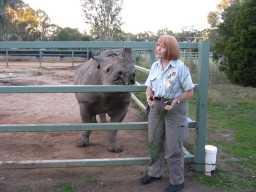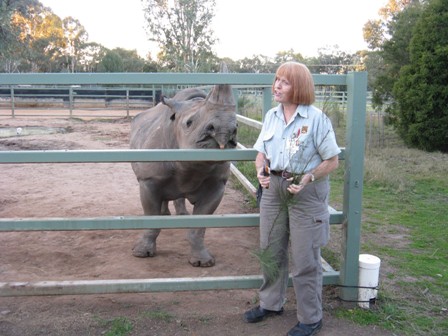Animals and Other Grown-ups at the Western Plains Zoo.
When meeting three Dr. Dolittles in two days, it’s a sure thing that talking to animals will be part of the fun. My first Dr. Dolittle, Helen Harris, introduces me to the behind-the-scenes activities at Dubbo’s Western Plains Zoo.
I check in at the recommended time, 3pm. Followed by a comprehensive orientation including a summary of my luxury tent’s features. The heated floor is welcome, its bushy seclusion peaceful. The accommodation area is locked at night “for security purposes”. “Is it to keep us in or the animals out?” I ask. “Both,” Harris informs me. “We lock the gate at 10pm but if you need to get out there’s an emergency phone. Guards patrol the grounds and you’re quite safe. It’s fenced because wallabies and kangaroos have a habit of scratching at the tents and we want to ensure that you get a good night’s sleep.”
Formerly a psychologist, now an insightful Zoo Guide, Harris’ passionate enthusiasm for animals knows no bounds. I ask her to nominate her favourites. The response surprises me. “Pythons. They have such distinct personalities. I have two at home, the diamond-back python wraps itself around my waist when we go for a walk.” A python walk is something I’ve never considered, an enveloping jaunt.
I feel as if I’m in East Africa. My tent overlooks the African Plains area of the zoo. Elands and giraffes are spread against the waning light, grazing. Two white rhinos gambol beyond the elands. A cleverly positioned fence and landscaped embankment separates us from the animals, the overall impression is space and freedom.
The first tour begins with the Sumatran tigers. We are allowed to approach from a metre’s distance. Shortly before our arrival keepers secreted bits of meat around the area, under logs, hidden in tree branches, in dense grass. Watching the two young tigers hunt, using their keen senses to locate the food is entrancing. Harris tells us that it’s to encourage them to use their natural instincts. “You can tell when they’re bored. “ She informs me. “They need constant stimulation and we do our best to test them. These two are brother and sister, just over a year old.”
The tigers obviously recognise Harris’ voice. They pause between snacks checking to see where she is. It’s an extraordinary interactive moment, us watching them, them watching Harris and Harris watching us to ensure that we don’t get too close. I’m tempted to reach past the wire and stroke the big cats, completely forbidden of course but tempting nonetheless.
We visit the meerkats, industriously preoccupied and very cute. They peer at us with keen curiosity while Harris distracts them with vegetable snacks. “This enclosure’s walls are dug metres deep into the ground. They’re expert excavators and would happily dig their way out very quickly,” she tells us. Again I notice how closely they pay attention to Harris’s voice, the Dolittle effect. I begin humming to myself, “If I could talk to the animals, learn their languages. Maybe take an animal degree…”
Our next stop is the siamang’s home. A Southeast Asian ape, the largest of the gibbon family, they live here on an island surrounded by bush. Harris tells us that they don’t swim and can’t leap across the expansive water barrier. She smoothly lobs a few apples onto the island. The grey-faced black-furred acrobats immediately begin searching for the special treats. “We’ve been able to breed the siamangs too,” Harris says. “We’re very good at match-making here. It’s a great job for romantics.”
Harris saves her strongest feelings however for Kwanze, the black rhino bull that has been key to the zoo’s impressive reproductive tally. The Western Plains Zoo’s renowned breeding programme is well earned. “He’s just a gentle giant really,” offering Kwanze a casuarina limb. She hands me a smaller branch, instructing me to offer it from below. I’m not allowed to reach over the fence as he may raise his head suddenly. “He wouldn’t want to hurt you but his horn is sharp and he’s a very powerful animal.” No doubt. I’ve never been so close to a black rhino before, they’re famously edgy unlike their more placid cousins the white rhinos. “White rhinos are slightly larger than the black. The name comes from the Dutch word wijde, which means wide, referring to their lips. Black rhinos are browsers with pointed lips. White rhinos are grazers with cow-like lips.” Kwanze pulls another branch from Harris’ hand while she talks. He gazes at her with rapt attention.
During dinner, three wholesome courses cooked with flair accompanied by a Mudgee red chosen from the all-Australian wine list, conversation turns to our nocturnal safari. Todd Jenkinson, a Guide Supervisor, is taking us on the night tour, one of the highlights of the Zoofari Experience.
Jenkinson’s passion is for the Prezwalski horse, native to Mongolia and until recently, extinct in the wild. Western Plains Zoo has had remarkable success in breeding these exceedingly rare animals, sending horses to Mongolia in order to re-establish the species in its native habitat. Jenkinson tells me that he’s been invited on a fellowship programme monitoring the pioneering herd. Looking as excited as a kid in a lolly shop, he tells me he leaves before the end of the year. “Yeah, it’s a dream come true really. These horses are unique. To see them on their home turf will be very instructive. I can bring back what I learn and hopefully we’ll be able to continue breeding these amazing animals. They’re real survivors. Don’t miss seeing our newest addition, a three week old foal.” I make a note for the following day’s itinerary.
With Jenkinson we visit Happy the hippo, a cantankerous male whose name contradicts his behaviour. “If I was to get into his enclosure, he’d go at me in a minute,” says Jenkinson. Hippos are extremely territorial, short-tempered and not to be messed with. “But he’s a fascinating animal isn’t he?” asks Jenkinson. I agree, Happy is an impressive grumpy giant.
Finally we meet the lions. The male, in the prime of his life, stretches up for a titbit of meat Jenkinson extends from the end of a stick. He is easily four metres long, impressive to the point of cliché, a true king of beasts. A female licks the container that held the meat, tongue rasping audibly while she reaches the last drops of blood. Jenkinson is completely at ease with these huge cats. We stand there in awe. It’s very dark on a moonless night. The zoo closed many hours before and I feel as if we’re the only people around. It’s just us and the lions.
At dawn we’re joined by our morning guide, John Brett. “I used to drive tour buses showing people around Australia. Now I work here and this is better.” His favourites are the Sumatran tigers. “I helped raise the two adolescents you saw yesterday. They mean a lot to me. Did you see the little horses yet?” referring to Prezwalski’s horses and having a joke on Jenkinson’s passion for the small animals. “Todd’s mini horses, he’s crazy about them.” The camaraderie among the guides is heart-warming, the good humoured joking an added bonus.
“Let’s go feed the giraffes. They’ll be expecting us by now.” Brett carries a bucket of carrots to the giraffes, more than Bugs Bunny would eat in a week. A towering male extends his tongue to pluck a carrot from my fingers. “They have the largest hearts of any land animal,” he tells us. “It has to pump blood up to their heads. As you can see they have the longest tongues as well.”
Next up are the cheetahs. Two youngsters react instantly when one of the kids in our group runs quickly to his parents. The cheetahs’ instinctive movements, crouching and readying for a chase are fascinating. “Kids, please don’t run, or any of you adults either. The cheetahs want to chase anything that runs,” Brett explains. We stand still and are rewarded with direct eye contact.
Finally we visit the Asian elephants and the bongos, another rare animal the Western Plains Zoo is working to save. “It’s a pity that visitors just drive by the bongos and don’t stop to see them,” Brett says. He’s right. They’re strikingly beautiful large antelopes from central Africa. White and brown striped coats, long spiralled horns and great brown eyes combine in a singular animal of surprising delicacy. One takes bits of bread from my hand as gently as a breeze lifts an autumn leaf. I barely feel her moist lips.
My two days at the Western Plains Zoo are at an end. I bicycle around the zoo, catching up with animals I’ve missed, the short-clawed otters, the tapirs, dingos, onagers and the Prezwalski foal. I’ve had a marvellous time with my guides. Their ability to speak to animals is enviable. If I could have found the pushme-pullyu, my visit would have been perfect. Alas, the Doctors Dolittle wouldn’t tell me where it is.
Naked Facts:
The Western Plains Zoo is located only a few kilometres from Dubbo’s centre. It’s approximately five hour’s drive from Sydney. Flights service Dubbo from Sydney several times per day.
Zoofari Experience packages are available year round and include accommodation, three guided tours, all meals, free use of the zoo’s bicycles and private parking.
For reservations: Ph: (02) 6881 1488
Web: www.zoofari.com.au


